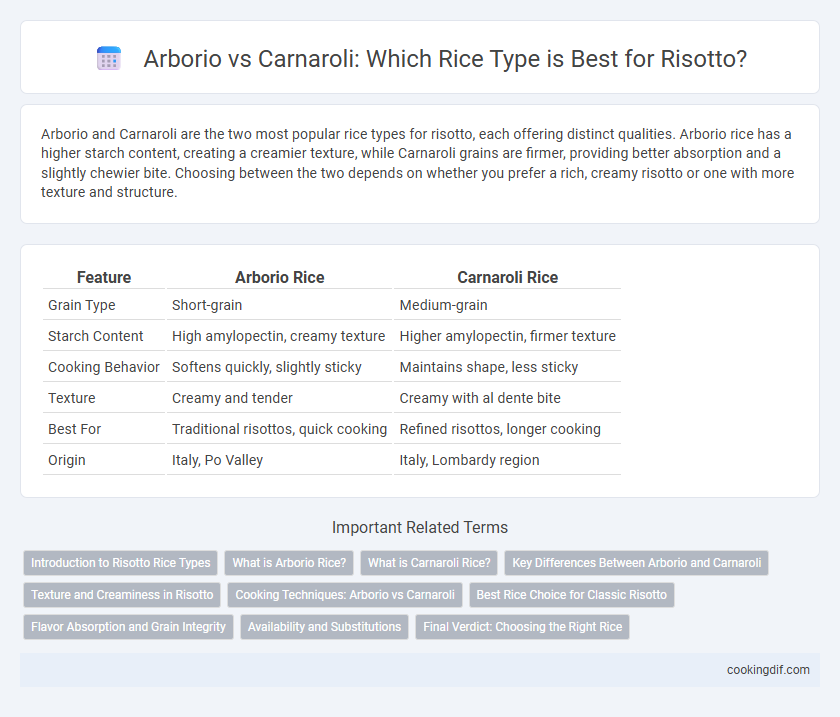Arborio and Carnaroli are the two most popular rice types for risotto, each offering distinct qualities. Arborio rice has a higher starch content, creating a creamier texture, while Carnaroli grains are firmer, providing better absorption and a slightly chewier bite. Choosing between the two depends on whether you prefer a rich, creamy risotto or one with more texture and structure.
Table of Comparison
| Feature | Arborio Rice | Carnaroli Rice |
|---|---|---|
| Grain Type | Short-grain | Medium-grain |
| Starch Content | High amylopectin, creamy texture | Higher amylopectin, firmer texture |
| Cooking Behavior | Softens quickly, slightly sticky | Maintains shape, less sticky |
| Texture | Creamy and tender | Creamy with al dente bite |
| Best For | Traditional risottos, quick cooking | Refined risottos, longer cooking |
| Origin | Italy, Po Valley | Italy, Lombardy region |
Introduction to Risotto Rice Types
Arborio and Carnaroli are two of the most popular rice varieties used in risotto, prized for their high starch content and creamy texture. Arborio rice has a plumper grain and releases starch quickly, creating a rich and creamy consistency, while Carnaroli is known as the "caviar of risotto rice" for its firm texture and superior ability to absorb liquids without becoming mushy. Choosing between Arborio and Carnaroli depends on the desired creaminess and bite, with Carnaroli preferred by chefs for professional-quality risotto.
What is Arborio Rice?
Arborio rice is a short-grain variety prized for its high starch content, which creates a creamy texture essential for authentic risotto dishes. It absorbs liquids well while maintaining a slightly firm center, offering a balanced bite. Compared to Carnaroli, Arborio is more widely available and often considered ideal for risotto beginners due to its forgiving cooking properties.
What is Carnaroli Rice?
Carnaroli rice is a premium Italian variety prized for its high starch content and firm texture, making it ideal for creamy risotto dishes. Compared to Arborio, Carnaroli grains are longer and absorb liquids more uniformly, resulting in a more stable, less mushy consistency. This rice variety retains its shape better during cooking, offering a perfect balance of creaminess and al dente bite sought by chefs worldwide.
Key Differences Between Arborio and Carnaroli
Arborio rice grains are shorter and plumper, releasing more starch quickly, which creates a creamier risotto texture, while Carnaroli grains are longer and firmer, maintaining their shape better during cooking for a more al dente result. Carnaroli has a higher starch content and a slightly longer cooking time, making it preferred by chefs for its ability to absorb flavors without becoming mushy. Arborio is more widely available and often used for everyday risotto dishes, but Carnaroli's superior texture and rice integrity make it ideal for gourmet recipes.
Texture and Creaminess in Risotto
Arborio rice offers a firm texture with a slightly chewy bite, ideal for risottos requiring a balanced structure, while Carnaroli rice provides a superior creamy consistency due to its higher starch content, enhancing the richness and smoothness of the dish. Carnaroli grains retain their shape better during prolonged cooking, making them preferred for professional chefs seeking an indulgently velvety risotto. The choice between Arborio and Carnaroli directly impacts the mouthfeel, with Arborio delivering a slightly al dente result and Carnaroli yielding a luxuriously creamy finish.
Cooking Techniques: Arborio vs Carnaroli
Arborio rice absorbs liquid quickly, making it ideal for a creamier risotto with a shorter cooking time of about 18 minutes, which requires constant stirring to release its starch. Carnaroli, known as the "king of risotto rice," has a firmer texture and higher starch content, allowing it to maintain its shape better during the longer 20-22 minute cooking process, making it more forgiving for less attentive stirring. Choosing between Arborio and Carnaroli depends on desired risotto texture and cooking technique precision.
Best Rice Choice for Classic Risotto
Arborio and Carnaroli are the two most popular rice varieties for classic risotto, each offering unique qualities. Arborio rice is known for its creamy texture and widespread availability, making it a versatile choice, whereas Carnaroli rice boasts a firmer, more al dente bite and superior starch content, resulting in a richer and silkier risotto. For authentic Italian risotto, Carnaroli is often considered the best rice choice due to its ability to absorb liquids and release starch while maintaining grain integrity during slow cooking.
Flavor Absorption and Grain Integrity
Arborio rice offers excellent flavor absorption with its slightly sticky texture that enhances the creamy consistency of risotto. Carnaroli rice is prized for maintaining superior grain integrity, providing a firm bite while still absorbing rich broths and seasonings intensely. Both varieties excel in flavor absorption, but Carnaroli's resilience during cooking gives it an edge for achieving a perfect al dente texture.
Availability and Substitutions
Arborio rice is widely available in most grocery stores and serves as a common choice for traditional risotto due to its creamy texture and accessibility. Carnaroli rice, often preferred by chefs for its firmer texture and better absorption, can be harder to find and is typically stocked in specialty or Italian markets. When Carnaroli is unavailable, Arborio acts as the primary substitute, while Vialone Nano offers an alternative for those seeking a middle ground in creaminess and firmness.
Final Verdict: Choosing the Right Rice
Carnaroli rice offers a creamier texture and greater resistance to overcooking compared to Arborio, making it the preferred choice for professional chefs seeking the perfect risotto. Arborio rice, while more widely available and budget-friendly, tends to release starch faster, resulting in a less firm but still delicious dish. For a balance of texture and ease, Carnaroli is recommended when aiming for a rich and authentic risotto experience.
Arborio vs Carnaroli for rice type Infographic

 cookingdif.com
cookingdif.com